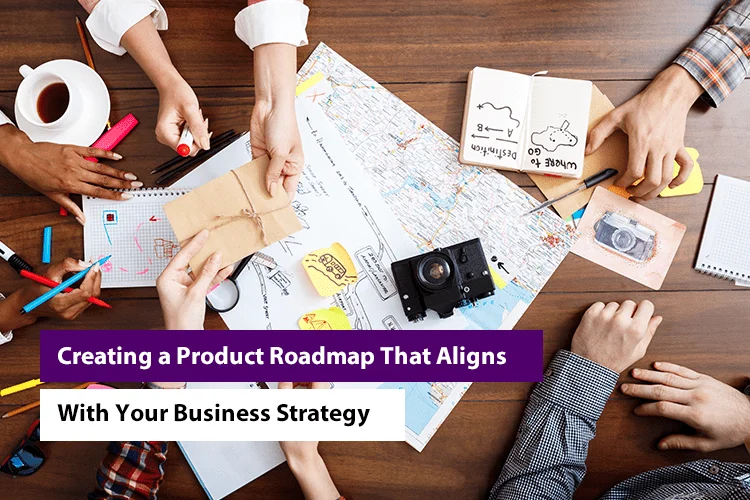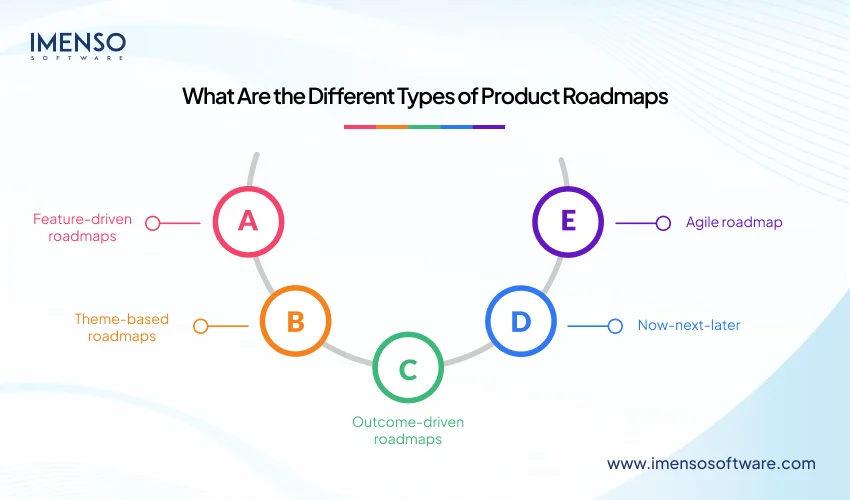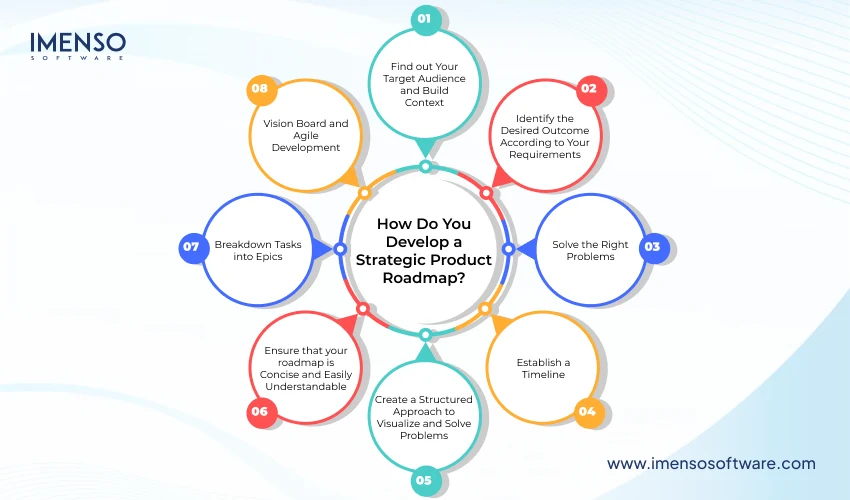Product Roadmap for Startups: Aligning With Your Business Strategy

“Whenever you see a successful business, someone once made a courageous decision.” Peter Drucker
Of course, the courageous decision can be starting a business. But it can also be creating a product roadmap. An effective roadmap presents a clear path forward, communicating how an organization’s short-term efforts align with its longer-term objectives. When done right, it aligns with your business strategy, keeping everyone involved focused on the highest priority efforts.
Imenso Software has helped multiple entrepreneurs and small businesses develop and enhance their products through visual design. Our comprehensive product roadmaps for startups and other businesses have given the guiding light needed to achieve success.
In this guide, we’ll understand what exactly is an effective product roadmap and how to create one that allows you to deliver quality products in a fast-paced environment.
What Is a Product Roadmap in Business?
Many product teams can design a stellar product. However, design is just the first step. A practical product roadmap template turns your product vision into a tangible project. It determines tasks that everyone involved needs to perform daily to achieve the product vision. A roadmap does not just describe the product. It also explains the organization’s strategic vision or the ‘why’ behind building it.
In simple words, a product roadmap is a strategic blueprint that outlines the direction, vision, priorities, and progress of a product throughout its lifecycle. This blueprint links the vision and strategy that you have for your product with the pragmatic steps required to make that vision a reality.
A product roadmap consists of various components. Their number mainly depends on the context and organization. However, some elements common to almost every product roadmap include the following:
Vision: Vision is a clear statement of the product’s ultimate goal and the unique benefits/value it brings to its users.
Goals and Objectives: Well-defined goals and objectives guide the roadmap’s development. They give the product manager the necessary direction for effective decision-making.
Themes and Initiatives: These are high-level focus areas for a product. Themes and initiatives provide a framework for prioritizing features.
Features: Features planned for the product, such as new offerings, enhancements, or major updates are described in a roadmap.
Timeline and Milestones: Timelines and milestones help with setting up a timeline for planned initiatives. This, in turn, facilitates optimal resource allocation and measurement of progress.
Dependencies: Interrelated features or tasks, indicating potential bottlenecks or areas where cross-team collaboration and coordination might be required.
Who Creates the Product Roadmap?
The product manager is primarily responsible for creating the product roadmap. Product managers are at the forefront of gathering research, feedback, and ideas. They translate this information into features and ultimately create a roadmap. After building the blueprint, it is shared with the stakeholders.
While the direct responsibility of creating a roadmap falls on the product manager, cross-functional collaboration always yields better results. Everything that a product manager does impacts other groups. Input from other teams in creating this important blueprint helps with delivering a Complete Product Experience (CPE).
The visibility that a product roadmap offers into the product’s course of action helps the entire organization to prioritize and plan its tasks.
What Are the Different Types of Product Roadmaps

A product roadmap is like a communications tool. So, they’re most effective when targeted at your audience. The roadmap style for you depends on what you wish to convey and your audience. Here are different types of product roadmaps.
Feature-driven product roadmap
These roadmaps focus on the release plan for new features. They outline the features that will be created and in what order.
Benefits
- Makes a clear link between features.
- Easy to view the workflow.
Theme-based roadmaps
These roadmaps begin with an overarching theme. Then they divide into subsets called epics. Epics are further split into stories to break down the theme more granularly. These roadmaps give you a clear glimpse of your larger goals. At the same time, it lets the team know what they need to do on a daily basis.
Benefits
- Gives an insight into how your daily tasks are tied to the bigger goal.
- Can be understood by less technical-savvy stakeholders.
Outcome-driven roadmaps
It focuses on the results instead of the product features. An example would be seeing how the release date of a product helps with the user experience. With this roadmap, teams can modify product features based on the outcome.
Benefits
- More adaptable than feature-based roadmaps
- Focuses on the outcome expected by the end-user rather than features.
Now-next-later
This roadmap helps you with your future planning while not missing out on immediate tasks. A now-next-later roadmap makes prioritizing simple. All you need to do is decide whether something is urgent. If yes, do it now. If not, do it later.
Benefits
- Easy to understand
- Shows how small tasks contribute to future goals.
- Makes prioritization simple
Agile roadmap
This style of roadmap plans out tasks in sprints. It also marks out the time taken by each sprint.
Benefits
- Aligns well with agile methodology workflows.
- Focuses on daily tasks and connects them to product goals
How Do You Develop a Strategic Product Roadmap?

There are many steps involved in the creation of a perfect roadmap. Let’s look at all of them in detail.
Find out Your Target Audience and Build Context
As mentioned before, roadmaps are a communication tool. So, you have to first determine the people for whom the roadmap is for. For example, the internal roadmap of your engineering team will not have the same topics as a roadmap built for your end users.
Find out who will review the content in the roadmap and their expectations. In other words, you must clearly define your target audience.
Now, examine the trajectory of your business. The roadmap must change as your company grows and evolves. For example, a roadmap to balancing numerous products across various markets for a big organization will be different from creating an MVP for a startup.
Identify the Desired Outcome According to Your Requirements
You must be fully clear about your business objectives and the project’s purpose. Are you developing a new product or improving an existing one?
Building a new product begins with ideation. You need to define the minimum viable product (MVP) for users. It’s also important to test the product’s features and functionality. Understanding MVP enables you to implement the most important features and gain user feedback. With this feedback begins a process of iterative improvements.
Find a few critical components and conceptualize them with your teammates and stakeholders:
Desired outcome
What is the business need you want to address? For example, “become the number 1 t-shirt printing e-commerce store in South America.”
Impact metrics
Identify the metrics that indicate that you are making progress with solving a problem. For example, your business could increase the regular order size to five products per customer.
Behavior metrics
What changes in user behaviors are needed for you to achieve your goals? As an example, your strategy could focus more on top-of-funnel users, or reactivate churned customers to boost revenue.
Solve the Right Problems
Solving correct problems means improving your product to solve user problems. A product that can give value to customers positively impacts your metrics. Here are some ways to identify problems related to your desired outcomes.
Customer feedback
Conducting user interviews is a great way to discover user problems. To obtain more data sources, get feedback from your marketing team. Pay attention to social listening, customer service, sales, and other departments that impact end users.
Gather and assess usage data.
You may not always get to hear what your customers want directly from their mouths. So, find out how your customers are using your product. Identify the reasons behind their purchasing of your product.
Product backlog
Keep your backlog updated while identifying problems. Analyze each component to determine if it offers value, has an owner, and fits within the broader strategy for the product.
Researching competitors and the market
Your industry competitors are also like you solving problems. It is crucial to be aware of what they are doing and how they are approaching your target audience.
After deciding on your goal, map out user stories. Use the user-driven approach to discover requirements from the user’s perspective.
Establish a Timeline
Your roadmap should have a realistic timeframe within which you achieve your product-related goals. Some problems have a straightforward solution. You can easily eliminate them through testing for a few months.
However, other products require the implementation of strategic changes which can take several years.
Whatever the case, a product roadmap template must indicate progress. It will prevent you from blindly running after outcomes that may not provide any value to your business for many more years.
Create a Structured Approach to Visualize and Solve Problems
You should now have a reverse funnel, going from a specific outcome to a few impact metrics and then a list of problems to solve (and possibly some existing backlog items that fit).
At this point, you will have a few important things in front of you. There will be a reverse funnel going from a specific outcome to a couple of impact metrics. You will also have a list of issues to solve, including backlogs.
The sight may not be pleasant. However, it is crucial to visualize this flow from goal to potential solutions.
Ensure that your roadmap is Concise and Easily Understandable
Effective product development is a result of a team that is aligned toward the same goal. This is much more likely to happen if it understands the the role of product in its development.
To this end, it is important to keep the roadmap simple and easy to understand. A detailed (and complicated) plan only causes miscommunication and missed deadlines. Contrarily, a clear and concise roadmap keeps everyone involved focused and motivated.
Breakdown Tasks into Epics
Now that you have a timeline, divide the tasks into minor epics. An epic is a huge chunk of work segmented into smaller tasks. These are called user stories. If your project is highly complex, it may have six levels. But if it is smaller, it will likely have only three levels.
Vision Board and Agile Development
Now, in the final stages of your roadmap, you will compile everything on a vision board. This ensures that it is easily accessible to all. Everyone involved can track the progress of the development process.
It is recommended to follow an agile approach to product development. This methodology prioritizes testing at each epic level. So, you don’t have to wait to test till the entire product is developed. You can also determine the time taken by each task using the existing resources. It makes you more flexible to adapt to unexpected changes that may arise during the development.
Analyze Your Product Roadmap
No roadmap is perfect. You will inevitably face obstacles at various points. It is critical to align your team’s efforts in a way that all deadlines are met. As a best practice, review your roadmap whenever an issue occurs.
You can safeguard your roadmap by reviewing it whenever a problem arises. Ask yourself the following questions:
- Did you anticipate this problem?
- Is there an immediate and long-term solution available to you?
- How will the team resolve this issue?
- What resources will be required?
Also Read:
Tools and Techniques for Effective Feature Prioritization
The Role of Data in Feature Prioritization: Making Better Decisions
The Impact of Cash Flow on Business Growth: Tips for Founders
Driving Project Success With an Effective Product Roadmap
The most successful product managers treat the planning of a big project as that of a road trip. They decide on a project’s final goal, just like they would identify their main destination. Similar to planning the main roads and exits, they map out the key milestones, such as starting on the main highway, merging into secondary routes, and more.
While planning a road trip, you don’t need to know every single stop along the way. Rather, you stay focused on the high-level route. Similarly, while creating a product roadmap, the key is knowing the overall path and adjusting as needed while staying aligned with the destination.
An impactful roadmap needs strategy, collaboration, and software. As a top software development company, we have not only built comprehensive product roadmaps for diverse businesses but we also regularly mentor trailblazers in building market-leading products. If you are ready to harness the success that comes with effective product roadmaps, contact us today. Also visit our portfolio here!
Want more information about our services?
Similar Posts

How IT Services Can Help Startups Innovate Faster
Is your startup grappling with operational challenges as it scales? Communication breakdowns and data management issues can impede innovation and growth. Project delays are also a significant obstacle to growth. According to FinancesOnline, 40% of executives site upgraded operational efficiency as the top advantage of digital transformation. Strategic IT services can help startups overcome challenges. Startups […]...

The Impact of Cash Flow on Business Growth: Tips for Founders
Have you ever wondered why your business cannot grow further while you are still receiving sales? Is your money being poured out as fast as it is being poured in? There is an invisible force that upholds any agreeable business, and that force is cash flow. If not managed well, it can hold your startup […]...

Offshore vs. Nearshore vs. Onshore Development: What’s Best for Scaling Startups?
Startup entrepreneurs find building an effective development team at affordable prices challenging. The executives must choose between working with local developers or overseas workers. Also, it’s tough to choose between domestic developers and overseas outsourcing. But, this will help you optimize price, quality maintenance, and team bonding. WhatsApp represents a successful company whose operations significantly […]...









